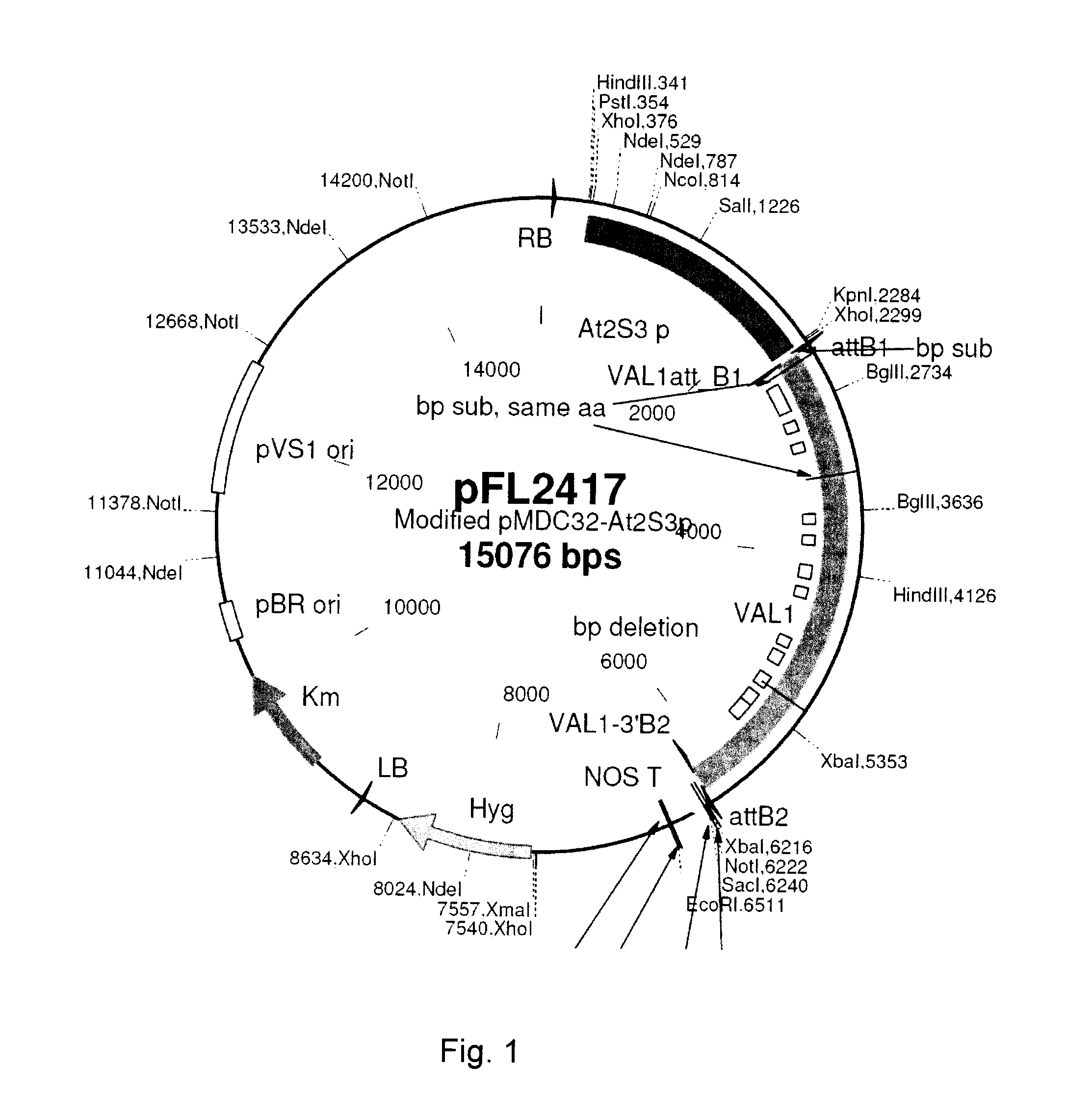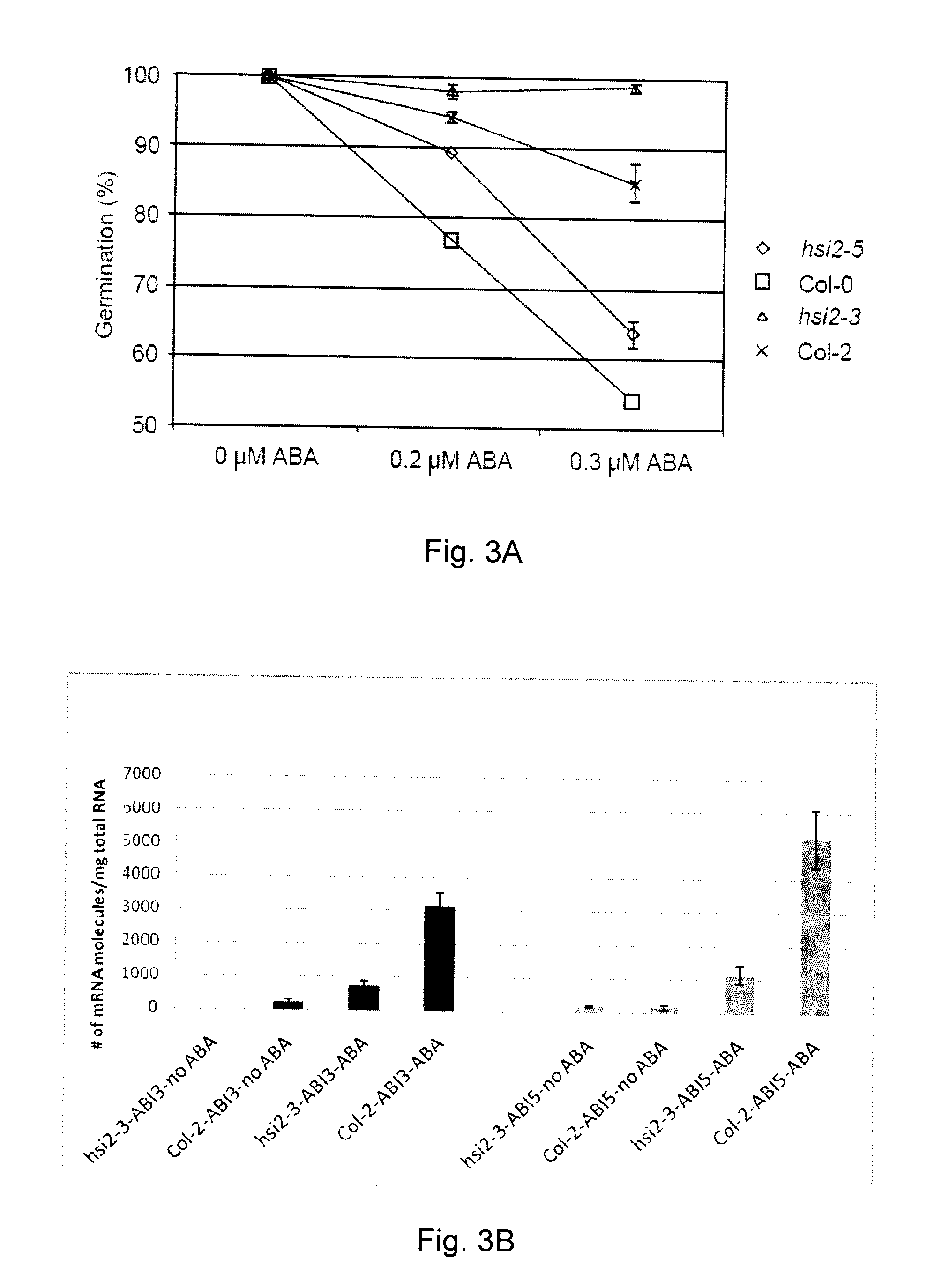Increased Seed Oil and Abiotic Stress Tolerance Mediated by HSI2
- Summary
- Abstract
- Description
- Claims
- Application Information
AI Technical Summary
Benefits of technology
Problems solved by technology
Method used
Image
Examples
example 1
Transformation of Plant Material
[0052]The genomic protein coding region of At2g30470, was cloned from the bacterial artificial chromosome T6B20 into cloning vector pJM1 by recombination as described by Liu et al. (Liu 2003) and subsequently into the binary T-DNA vectors pDMC32:At2S3 and pER330 using Gateway technology (Invitrogen). Agrobacterium strain GV3101 (MP90) harboring the T-DNA vector was used to transform the At2S3 (napin):HSI2 and cauliflower mosaic virus 35S:HSI2 gene constructs into Arabidopsis thaliana (Columbia-0 ecotype) by floral dipping. The vectors were also transformed into Brassica napus (DH12075) as described by Zou et al. (Zou 1997). The At2S3 (napin):HSI2 vector map is shown in FIG. 1.
[0053]Two putative hsi2 T-DNA insertion lines were identified in Arabidopsis thaliana (Columbia-0 and Columbia-2 backgrounds) from the Salk Institute Genomic Laboratory Genomic database (http: / / signal.salk.edu) and seeds were obtained from the Arabidopsis Biological Resource Cent...
example 2
Seed Oil Analysis
[0054]Seeds of T-DNA insertion mutant lines of HSI2 and the wild type were stratified in the dark for 3 days at 4° C. and sown on Sunshine™ Mix4 germination medium (Sun Gro Horticulture, Canada). Plants were germinated and grown in a growth chamber (Conviron) under 16-hr photoperiod, 21 / 18° C. day / night temperature cycle and about 250 μE light intensity. Secondary shoots were trimmed out and siliques on primary shoots were allowed to dry on plants before moving to a finishing chamber for another 2 weeks to ensure complete ripening of seeds. Seeds were harvested only from main shoots and allowed to dry at room temperature for 2-3 weeks before analyzing for seed oil content and fatty acid profiles.
[0055]Total lipids were extracted by grinding seeds in chloroform:isopropanol (2:1). The solvent was evaporated off at room temperature under a stream of nitrogen gas and total lipids were transmethylated by heating samples with 3 N methanolic HCl at 80° C. for 3 hrs. Fatty ...
example 3
[0058]Seeds were surface-sterilized with 30% bleach (0.01% Tween™-20), rinsed several times with sterilized water, and sown on 1.5% agar plates containing half-strength Murashige and Skoog (MS) salt solution supplemented or not with 0 μM, 0.25 μM or 0.3 μM ABA (±ABA, Toray batch; PBI 58, NRC / PBI Saskatoon). The plates were transferred to a tissue culture room after a cold treatment of 2 days at 4° C. in the dark, and incubated at 20° C. / 16° C. day / night temperatures under a 16 hrs / 8 hrs light / dark regime and 80-100 μE irradiance.
[0059]Germination (defined as endosperm rupture and radical emergence) was scored starting 24 hrs after seed stratification. Germination events are expressed as a percentage of the total number of seeds per plate. Germination experiments were repeated at least three times using three different seed batches of wild type and T-DNA insertion mutant lines (hsi2-5 and hsi2-3) grown in parallel.
[0060]Both of the T-DNA insertion mutant liens showed a dec...
PUM
| Property | Measurement | Unit |
|---|---|---|
| Fraction | aaaaa | aaaaa |
| Electrical resistance | aaaaa | aaaaa |
| Sensitivity | aaaaa | aaaaa |
Abstract
Description
Claims
Application Information
 Login to View More
Login to View More - R&D
- Intellectual Property
- Life Sciences
- Materials
- Tech Scout
- Unparalleled Data Quality
- Higher Quality Content
- 60% Fewer Hallucinations
Browse by: Latest US Patents, China's latest patents, Technical Efficacy Thesaurus, Application Domain, Technology Topic, Popular Technical Reports.
© 2025 PatSnap. All rights reserved.Legal|Privacy policy|Modern Slavery Act Transparency Statement|Sitemap|About US| Contact US: help@patsnap.com



